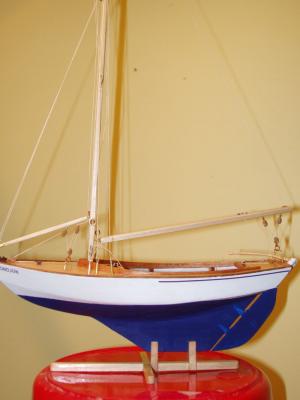-
Posts
208 -
Joined
-
Last visited
Content Type
Profiles
Forums
Gallery
Events
Posts posted by Yambo
-
-
Can I use a chainsaw?
Cut it a the right angle, lay it in a sandpit and have a model of an old shipwreck.

Brave decision Mark, Licorne v.2 will be to your satisfaction I'm sure.
- 42rocker, harvey1847 and mtaylor
-
 3
3
-
-
Good thread.
I really like the look of the Euromodel La Renomme'e but I have quite a bit on the go at the moment. I'm tempted to buy it fairly soon and put it on the 'pending shelf'.
-
Thanks for the tip Mark, but it would have to be a VERY small chess set - the Crown is only 4mm high
 .
. Danny
DannyTravel chess set? They'll be plastic of course but I'm sure you'd be able to make them look good.

-
My absolute favourite is the little one laying on top - its about 5cm (2inches) blade and about 42tpi..and the cleanest cut I have seen.
I got them from Deiters fine tools in Germany - as it was just as quick and cost about the same shipping as somewhere in Australia - and cheaper for the items,
Mine arrived from Germany today. I used your recommendation Meredith so . . .

I have an old set of Zona saws back home and was thinking replacing them when this thread came up. My Christmas trip to the UK enables me to stock up on tools and other bits and pieces that it's hard to find in Turkey so I ordered the saw just after Christmas. No complaints about the service from Dieter Schmid's. I like the look of the Incra rules they stock - I might try the shipping service to Turkey in the next month or so.
-
Well, don't give yourself too much work by changing things too much. Your talent will be better served by making a perfect model of an actual boat and let's face it, the second image shows a cockpit much the same as you have made ergo, it's just fine.

Please don't think I'm criticising here, the format of your model should be as you want it. For me, the skill workmanship that has gone into it speaks far more than the design. I can't wait to see it launched.

-
Forgive my ignorance Michael but having looked again at your earlier pictures where you scaled yourself against the Cutter (I've been following along avidly as your work is beautiful), what would be the preferred way of getting from the cockpit to the cabin and how would that be made easier with a higher coaming?
Unlike yourself, I certainly haven't done any research into this but if the cockpit had direct access from the cabin a higher coaming wouldn't be an issue. Anyway, as I said, I'm no expert!
-
-
Hi Yambo, Although at first glance they look the same, The Sakonnet daysailer has a Hard Chine hull,and The Herreshoff has a rounded bilge. if you were to compare them side by side they are 2 completly different boats
Best Regards,
Pete
I should have picked that up from the first plans picture but had a senior moment I guess.

Looking again and spending a bit more time, it looks a lovely little boat.
-
- pete48, yvesvidal and Elmer Cornish
-
 3
3
-
No offence Harvey but epoxy is too expensive to not read the instructions.

-
When you talk about "thickened" is that the way you buy it or is there an additive.
The West System G/Flex is a thicker epoxy than some of their other epoxies I've used but it will run into gaps and run downhill. Other epoxies are thinner, you have to do a bit of research really - I have a limited supply of epoxies here in Turkey but in the UK I was happy with MAS epoxy - but they do a range so you have to check that out.
Thickening epoxy to make it a better glue (epoxy is basically a coating) is done by adding wood flour, silica (or both) or fibreglass microfibres. Be very careful if using microfibres, They are definitely something you wouldn't want in your lungs. I always wear a mask if I'm using them. I always wear thin neoprene gloves when working with epoxy but I don't always wear a mask if just making up small amounts for models though. I probably should and do when I'm working on full size boats.
For fillets on seams everyone recommends that the epoxy is thickened to a peanut butter consistency and I make it about the same for filling holes before re-drilling them. I don't use de-natured alcohol for cleaning because I can't get a decent translation of the words here and no-one seems to know what I'm on about. I use acetone for thinning and cleaning up. For small batches I use plastic syringes to measure amounts - the G/Flex is a one to one mix but the other stuff I have here for a boat I'm refurbishing is a 3 to 2 mix. Mixing is critical and the key to a good coating or bond. There are also different speed hardeners to suit most applications and West Systems have a chart to show which of their epoxies/hardeners to use for different applications. Epoxy doesn't stick to polythene; I haven't tried wax paper.
Fibreglass isn't always necessary. As said, epoxy is a coating; fibreglass just adds strength to what you are doing. The boat in my yard is a plywood dinghy - about 40 years old. The plywood on the hull was starting to de-laminate in places so I glassed the whole bottom, It should be good for another 10 years or so, especially if I fillet the inside seams and add a couple of coats of epoxy in there. Just one other point; epoxy is affected by ultra violet light so a couple of coats of clear varnish will help if the treated item is going to get a lot of sunlight.
- Bedford and avsjerome2003
-
 2
2
-
What do you seal them with?
Augie, 5 min epoxy would not give me long enough to apply it all the way along the edge of a 1 metre plank and to all the frames and fit the plank, making sure it is properly seated and clamped all the way along.
I am planning to fibregalss the exterior and epoxy coat the interior pending better ideas.
Steve
West System G/Flex epoxy is great for fillets - I'll take a picture later - pot life is about 45 minutes and it sets up in a few hours. I can buy it locally in small containers (118 ml) and although it's not that cheap it's the best stuff I've found to fillet small seams. It's too thick for coating though hulls though. There are a lot of different epoxies unfortunately so it'll need a bit of research to find one that is thin enough to coat the outside of a hull and can be found locally. I have a love hate relationship with epoxy; it's a great coating for boat hulls, thickened, it's a great glue, but it's not cheap and horrible to work with.
- Bedford and fnkershner
-
 2
2
-
That looks good Popjack!
My MS Bluenose is sitting in the UK now waiting for me. I'm heading over there for Christmas and New Year and I'll bring it back with me in January. There'll be another Bluenose build log started shortly after.
-
Congratulations Ilhan, she looks beautiful!
-
-
-
Perhaps Proxxon is just a bigger company with wider distribution, especially worldwide,
That's the situation for me. There are lots of manufacturers out there that don't market their tools in Turkey. In addition, shipping costs and customs duties can more than double the price.
It seems that in the USA there's no problem in sourcing tools, any type of wood you want or whatever. It's slowly getting better here but we're a long way behind.
-
Right, my first request for input.
We all know what the inside is going to look like, a keel down the middle and ribs spaced along it, when planked there will be a void between each rib either side of the keel which I will need to be able to drain bilge water from.
If I drill holes in each rib to allow flow I then have to go to great lengths to make sure they are sealed completely to stop water getting into the ply and it will weaken the structure, if they are right at the bottom to allow all water to drain out then there will be nothing solid for the bottom planks to attach to.
From my own experience of working on full size boats, the best way to deal with any hole is to 'drill, fill and drill again'. That is, drill a hole, fill it with thickened epoxy and then drill through that (when it's set!) for the fixing. Done properly you'll leave a thin coating of epoxy around the circumference of the hole which seals the wood.
-
-
I bet the tension built up a bit, going into battle at around 3 - 4 mph!
Kids today don't know how well off they are!
-
-
However, I must say that these instruments are lifetime investments. You will not be sad if you save up the $100 or so for a quality American or Japanese made (Starrett, Browne and Sharpe, Mitutoyo etc.) calipers. Others may disagree, but I have several precision instruments purchased by my grandfather that are as good as the day they were made.
When my son was 16 he got an apprenticeship with British Aerospace and I bought him a Mitutoyo caliper - "You'll need one of these son!".
He tells me he's used it nearly every working day since then. He's now 34 and last Christmas I bought him another one with a couple more functions. He still has the first one I bought him.
I use a vernier caliper but keep thinking about changing to digital. Maybe one day . . .
-





Micro drill, pen-size
in Modeling tools and Workshop Equipment
Posted
I just use a pin vice for any drill up to about 1mm. Sometimes power is a pain . . .